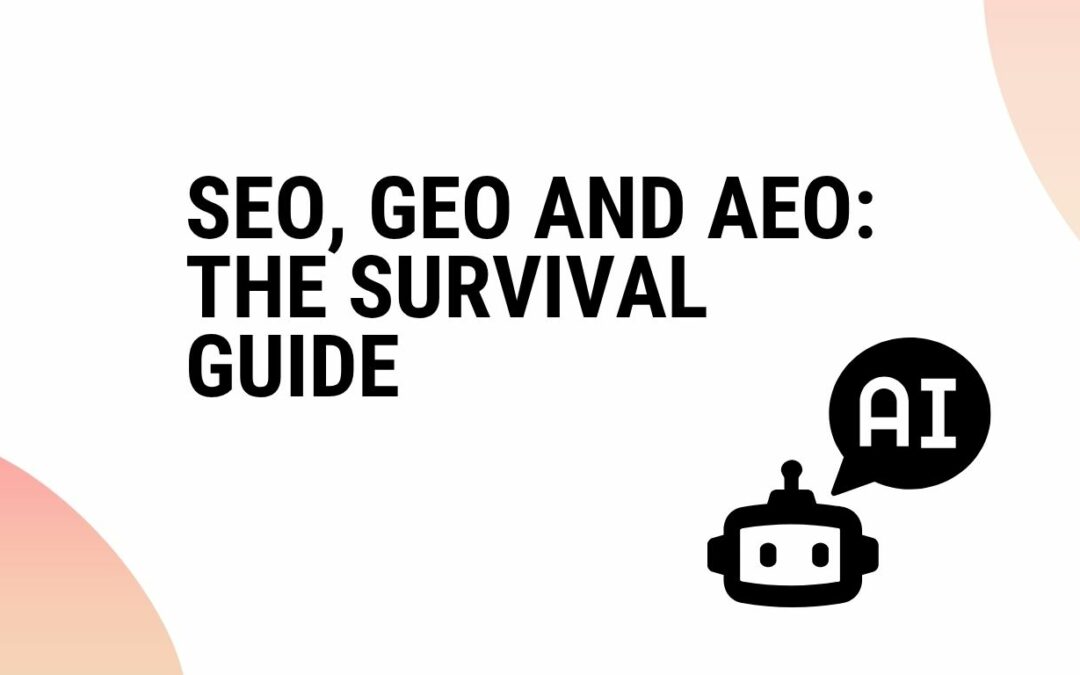Digital marketing is evolving at lightning speed.
Between Google’s constant updates, the rise of voice search, and AI-powered answer engines like ChatGPT and Gemini, staying visible online is tougher than ever.
To thrive in this new landscape, three elements are essential: SEO, GEO, and AEO.
Each plays a different role — but together, they form the foundation of a future-proof digital strategy.
1. SEO — Search Engine Optimization
What it means
SEO (Search Engine Optimization) is about making your website understandable and attractive to traditional search engines like Google.
It ensures your content appears when people search for what you offer.
Why it matters
Even with great design, a website without SEO is invisible.
If Google doesn’t know you exist — your audience won’t either.
Core principles
-
Technical performance: fast, responsive, and well-structured website.
-
Relevant content: clear, informative, and written for people, not algorithms.
-
Authority: earned through backlinks, mentions, and consistent expertise.
Example
A French café writing “How to make authentic Parisian croissants” can rank when users search “Paris croissant recipe”.
That’s SEO: matching human curiosity with digital structure.
2. GEO — Geographic Optimization
What it means
GEO (Geographic Optimization) focuses on improving your local visibility — both online and offline.
It ensures your business shows up when people search “near me” or use location-based platforms.
Why it matters
People want proximity and authenticity. Even global brands benefit from a local touch.
Core principles
-
Google Business Profile: complete, up-to-date, and regularly updated with posts and images.
-
Customer reviews: encourage real feedback and respond with care.
-
Localized content: tailor your message to specific cities or regions.
Example
A dental clinic in Lisbon that optimizes its Google profile and publishes blog posts like “Best teeth-whitening options in Lisbon” will rank higher in local searches.
That’s GEO — bridging online presence and physical location.
3. AEO — Answer Engine Optimization
What it means
AEO (Answer Engine Optimization) prepares your content for AI-driven engines that deliver direct answers — like ChatGPT, Perplexity, or Google Gemini.
Instead of ranking in search results, your goal is to become the cited answer.
Why it matters
Users now ask questions in natural language, and AI tools deliver instant responses.
If your content is structured and trustworthy, these systems can use it directly.
Core principles
-
Structured data: clear headings, bullet points, concise phrasing.
-
Trust signals: expertise, author credentials, and verified sources.
-
Q&A format: include questions people actually ask.
Example
A travel agency writing “What’s the best time to visit Japan?” with a direct, factual answer might be quoted by AI assistants.
That’s AEO: being the answer, not just one of many results.
4. Why They Work Better Together
These three strategies complement each other:
| Strategy | Objective | Real-World Impact |
|---|---|---|
| SEO | Global online visibility | Your content ranks on Google |
| GEO | Local visibility | Customers find you nearby |
| AEO | AI and answer engine visibility | AI tools cite your content |
Used together, they create a holistic ecosystem that covers every layer of digital discovery — search, location, and conversation.
5. Building a Future-Proof Strategy
-
Start with user intent: what people search, where they search, and how they phrase questions.
-
Write for humans first: algorithms reward what people actually value.
-
Unify SEO, GEO, and AEO: structure your content so it’s findable, relatable, and quotable.
The future of marketing belongs to brands that blend human authenticity with algorithmic clarity.
Technology changes fast, but human needs stay constant: relevance, trust, and clarity.
By combining SEO, GEO, and AEO, you create a digital presence that adapts to every platform — from Google to AI assistants.
Stay visible, stay credible, stay human.
FAQ: SEO, GEO, and AEO Explained
1. What’s the difference between SEO, GEO, and AEO?
-
SEO improves your website’s visibility on traditional search engines.
-
GEO focuses on local visibility and physical proximity.
-
AEO prepares your content to be cited by AI-powered answer systems.
2. Is SEO still important with AI and answer engines?
Yes. SEO remains the foundation of online visibility. Even AI tools rely on well-optimized, authoritative websites to source accurate information.
3. How can small businesses use GEO effectively?
Keep your Google Business Profile up to date, collect genuine reviews, and publish local content. GEO helps smaller brands compete regionally, even against larger competitors.
4. What type of content works best for AEO?
Structured, factual, and concise content. Think FAQs, guides, tutorials, and “how-to” posts — anything that directly answers a question.
5. Can SEO, GEO, and AEO be managed together?
Yes, and they should be. Together they build a consistent, trustworthy online presence across search engines, maps, and AI platforms.

